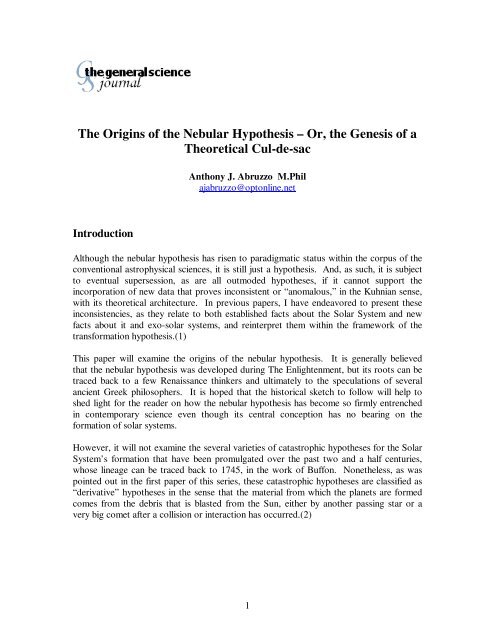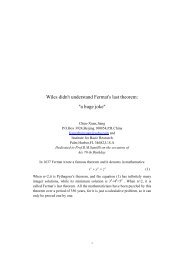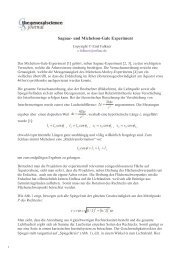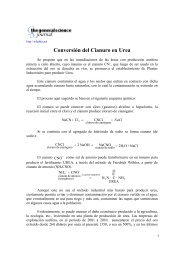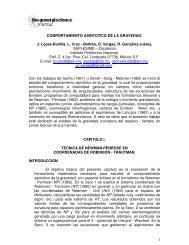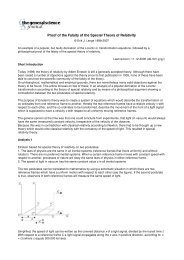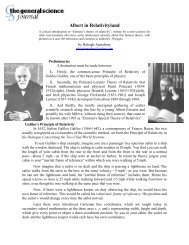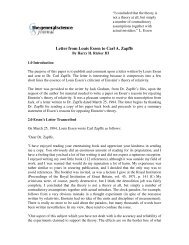The Origins of the Nebular Hypothesis - The General Science ...
The Origins of the Nebular Hypothesis - The General Science ...
The Origins of the Nebular Hypothesis - The General Science ...
Create successful ePaper yourself
Turn your PDF publications into a flip-book with our unique Google optimized e-Paper software.
<strong>The</strong> <strong>Origins</strong> <strong>of</strong> <strong>the</strong> <strong>Nebular</strong> Hypo<strong>the</strong>sis – Or, <strong>the</strong> Genesis <strong>of</strong> a<br />
<strong>The</strong>oretical Cul-de-sac<br />
Introduction<br />
Anthony J. Abruzzo M.Phil<br />
ajabruzzo@optonline.net<br />
Although <strong>the</strong> nebular hypo<strong>the</strong>sis has risen to paradigmatic status within <strong>the</strong> corpus <strong>of</strong> <strong>the</strong><br />
conventional astrophysical sciences, it is still just a hypo<strong>the</strong>sis. And, as such, it is subject<br />
to eventual supersession, as are all outmoded hypo<strong>the</strong>ses, if it cannot support <strong>the</strong><br />
incorporation <strong>of</strong> new data that proves inconsistent or “anomalous,” in <strong>the</strong> Kuhnian sense,<br />
with its <strong>the</strong>oretical architecture. In previous papers, I have endeavored to present <strong>the</strong>se<br />
inconsistencies, as <strong>the</strong>y relate to both established facts about <strong>the</strong> Solar System and new<br />
facts about it and exo-solar systems, and reinterpret <strong>the</strong>m within <strong>the</strong> framework <strong>of</strong> <strong>the</strong><br />
transformation hypo<strong>the</strong>sis.(1)<br />
This paper will examine <strong>the</strong> origins <strong>of</strong> <strong>the</strong> nebular hypo<strong>the</strong>sis. It is generally believed<br />
that <strong>the</strong> nebular hypo<strong>the</strong>sis was developed during <strong>The</strong> Enlightenment, but its roots can be<br />
traced back to a few Renaissance thinkers and ultimately to <strong>the</strong> speculations <strong>of</strong> several<br />
ancient Greek philosophers. It is hoped that <strong>the</strong> historical sketch to follow will help to<br />
shed light for <strong>the</strong> reader on how <strong>the</strong> nebular hypo<strong>the</strong>sis has become so firmly entrenched<br />
in contemporary science even though its central conception has no bearing on <strong>the</strong><br />
formation <strong>of</strong> solar systems.<br />
However, it will not examine <strong>the</strong> several varieties <strong>of</strong> catastrophic hypo<strong>the</strong>ses for <strong>the</strong> Solar<br />
System’s formation that have been promulgated over <strong>the</strong> past two and a half centuries,<br />
whose lineage can be traced back to 1745, in <strong>the</strong> work <strong>of</strong> Buffon. None<strong>the</strong>less, as was<br />
pointed out in <strong>the</strong> first paper <strong>of</strong> this series, <strong>the</strong>se catastrophic hypo<strong>the</strong>ses are classified as<br />
“derivative” hypo<strong>the</strong>ses in <strong>the</strong> sense that <strong>the</strong> material from which <strong>the</strong> planets are formed<br />
comes from <strong>the</strong> debris that is blasted from <strong>the</strong> Sun, ei<strong>the</strong>r by ano<strong>the</strong>r passing star or a<br />
very big comet after a collision or interaction has occurred.(2)<br />
1
<strong>The</strong> History Of <strong>The</strong> <strong>Nebular</strong> Hypo<strong>the</strong>sis<br />
<strong>The</strong> Ancient Greeks<br />
In its most basic form, <strong>the</strong> nebular hypo<strong>the</strong>sis posits <strong>the</strong> coalescence <strong>of</strong> celestial bodies<br />
from a primitive cloud <strong>of</strong> tenuous matter that fills all <strong>of</strong> space and is set in motion by<br />
some fundamental force. This scheme can be found in <strong>the</strong> cosmogony <strong>of</strong> <strong>the</strong> 5 th century<br />
BC, Greek thinker, Anaxagoras <strong>of</strong> Clazomenae. For Anaxagoras, “nous” or mind played<br />
<strong>the</strong> dual role <strong>of</strong> being <strong>the</strong> tenuous matter and <strong>the</strong> motive force that gives rise to <strong>the</strong> visible<br />
universe. For him, nous is “…<strong>the</strong> thinnest <strong>of</strong> all things and <strong>the</strong> purest…” and it “…set in<br />
order all things that were to be, and all things that were and are not now and that are, and<br />
this revolution in which now revolve <strong>the</strong> stars and <strong>the</strong> sun and <strong>the</strong> moon, and <strong>the</strong> air and<br />
<strong>the</strong> ae<strong>the</strong>r that are separated <strong>of</strong>f.”(3)<br />
<strong>The</strong> schools <strong>of</strong> Leucippus, Democritus and Epicurus, replaced <strong>the</strong> virtually insubstantial<br />
nous with an infinite variety <strong>of</strong> material atoms. <strong>The</strong>se atoms are in a state <strong>of</strong> eternal<br />
vortical motion in <strong>the</strong> infinite void. <strong>The</strong> bodies <strong>of</strong> <strong>the</strong> visible cosmos form when <strong>the</strong><br />
atoms commingle to create a dense mass, this being <strong>the</strong> physical equivalent <strong>of</strong> what<br />
would eventually be referred to as a nebula by Enlightenment thinkers. <strong>The</strong>se material<br />
bodies persist for a time and, <strong>the</strong>n, dissolve back into <strong>the</strong> constituent atoms from which<br />
<strong>the</strong>y were formed. Throughout this endless process <strong>of</strong> coming to be and passing away,<br />
however, <strong>the</strong> atoms <strong>the</strong>mselves remain unchanged. <strong>The</strong> Roman poet and philosopher<br />
Lucretius, an adherent <strong>of</strong> <strong>the</strong> Epicurean school, gives a detailed account <strong>of</strong> <strong>the</strong> world’s<br />
creation by this process in his On <strong>The</strong> Nature Of Things.(4) It is interesting to note that<br />
in this ancient version <strong>of</strong> <strong>the</strong> nebular hypo<strong>the</strong>sis, it is <strong>the</strong> Earth that forms in <strong>the</strong> center <strong>of</strong><br />
<strong>the</strong> condensing mass from <strong>the</strong> grossest elements while <strong>the</strong> lightest parts move to <strong>the</strong><br />
periphery <strong>of</strong> creation to become <strong>the</strong> e<strong>the</strong>r, with Sun, moon and stars taking up positions<br />
midway between <strong>the</strong> two.<br />
<strong>The</strong>se early attempts at a materialistically based evolutionary cosmogony, with its<br />
nascent nebular hypo<strong>the</strong>sis, eventually succumbed to <strong>the</strong> static Aristotelian/Ptolemaic<br />
cosmology, which, owing to its incorporation into <strong>the</strong> Christian worldview, would come<br />
to dominate western thought for <strong>the</strong> next fifteen centuries. This stranglehold on scientific<br />
progress began to loosen, however, in <strong>the</strong> latter part <strong>of</strong> <strong>the</strong> Renaissance period.<br />
<strong>The</strong> Return To An Evolutionary Cosmogony<br />
Nicholas <strong>of</strong> Cusa, Giordano Bruno and Rene Descartes, whose works span <strong>the</strong> 15 th , 16 th<br />
and 17 th centuries respectively, stand out as forerunners for what would become <strong>the</strong><br />
“modern” cosmological worldview. Each thinker, in his own unique way, challenged <strong>the</strong><br />
authority <strong>of</strong> <strong>the</strong> Aristotelian/Ptolemaic-based cosmology and, in so doing, weakened its<br />
rotting foundation that o<strong>the</strong>rs who followed in <strong>the</strong>ir paths would completely demolish. In<br />
taking on this project, <strong>the</strong>y played a dangerous game with <strong>the</strong> Church authorities, which<br />
led to suspicion in Cusa’s case, Bruno’s execution(5), and voluntary exile in Holland for<br />
Descartes. How fortunate, <strong>the</strong>n, are <strong>the</strong> dissident cosmologists <strong>of</strong> today whose works are<br />
merely ignored by <strong>the</strong> “orthodox” scientific community.<br />
2
Although Nicholas <strong>of</strong> Cusa did not produce an evolutionary based cosmogony, he did put<br />
forward <strong>the</strong> ideas, scattered in his numerous writings, that <strong>the</strong> universe is infinite<br />
(although prudence moved him in later writings to revise this position to<br />
“indeterminate”), that <strong>the</strong> Earth has motion and is not <strong>the</strong> “center” <strong>of</strong> creation, and that it<br />
and <strong>the</strong> stars are essentially alike and composed <strong>of</strong> similar substances. Nicholas also<br />
opposed <strong>the</strong> sacrosanct Aristotelian notion that heavenly bodies revolve with perfect<br />
circular motion, thus anticipating Kepler’s discovery <strong>of</strong> elliptical orbits in 1609, one<br />
hundred thirty-five years after his death in 1464.<br />
Bruno accepted much <strong>of</strong> Nicholas’ teachings, although he didn’t hedge with respect to his<br />
belief that <strong>the</strong> universe is infinite. It was a certainty for him. He also embraced <strong>the</strong> new<br />
Copernican heliocentric worldview. He accepted <strong>the</strong> atomism <strong>of</strong> Democritus and<br />
Epicurus, and rejected virtually all <strong>of</strong> Aristotle’s cosmology, <strong>of</strong>ten sniping at its various<br />
tenets in biting and sarcastic language. For him, <strong>the</strong> real world consisted <strong>of</strong> “…an<br />
infinite Plenum and an infinite Vacuum, <strong>the</strong> one placed within <strong>the</strong> o<strong>the</strong>r.”(6)<br />
As mentioned above, Bruno’s universe consists <strong>of</strong> <strong>the</strong> plenum, which contains <strong>the</strong> various<br />
elements and <strong>the</strong> bodies <strong>the</strong>y form like <strong>the</strong> Earth and <strong>the</strong> Sun. <strong>The</strong> plenum is contained in<br />
<strong>the</strong> vacuum, which is ano<strong>the</strong>r name for an all-pervading e<strong>the</strong>r-like substance. <strong>The</strong> e<strong>the</strong>r<br />
is like a substratum in which <strong>the</strong> elements and bodies reside. One might think <strong>of</strong> it as <strong>the</strong><br />
evanescent “glue” that suffuses <strong>the</strong> visible world and holds it toge<strong>the</strong>r. Within this<br />
elemental soup bodies are “…constantly dispersed and constantly reassembled: <strong>the</strong>y send<br />
forth <strong>the</strong>ir substance, and receive within <strong>the</strong>mselves wandering substance.”(7)<br />
Curiously, Bruno is not definitive about whe<strong>the</strong>r <strong>the</strong> Earth and o<strong>the</strong>r bodies had an<br />
absolute beginning or are “eternal.” However, he does allow that if <strong>the</strong>y are eternal, “…it<br />
is not so by virtue <strong>of</strong> <strong>the</strong> stability <strong>of</strong> any one part or individual, but through <strong>the</strong><br />
vicissitudes <strong>of</strong> many parts, some being expelled <strong>the</strong>refrom, and <strong>the</strong>ir place taken by<br />
o<strong>the</strong>rs.”(8) Thus, if <strong>the</strong> eternity <strong>of</strong> bodies is accepted as a fact, it is <strong>the</strong> form that persists,<br />
what he calls “soul and intelligence,” while <strong>the</strong> matter or elemental parts are in a state <strong>of</strong><br />
continual flux.<br />
Although this scheme does not evoke <strong>the</strong> explicit image <strong>of</strong> a condensing nebula<br />
composed <strong>of</strong> elementary material, it is evolutionary in <strong>the</strong> sense that bodies undergo a<br />
process <strong>of</strong> “external” material change. Thus, while, for example, <strong>the</strong>re is only one<br />
“essential” or noumenal Earth, <strong>the</strong>re are, throughout eternity, many “accidental” or<br />
phenomenal Earths. None<strong>the</strong>less, although this may not seem to represent much <strong>of</strong> an<br />
advance over <strong>the</strong> Aristotelian/Ptolemaic cosmology from a modern scientific perspective,<br />
it was, in fact, a significant leap forward in thinking. By embracing <strong>the</strong> Democritean and<br />
Epicurean notion <strong>of</strong> atoms mixing in a void, Bruno was able to impart a dynamic quality<br />
to his cosmogony that <strong>the</strong> orthodox view current in his time completely lacked.<br />
Descartes, however, attempted <strong>the</strong> most thoroughgoing and ambitious evolutionary<br />
cosmogony during this period, although he prudently couched it in hypo<strong>the</strong>tical terms in<br />
order to escape <strong>the</strong> reproach <strong>of</strong> <strong>the</strong> Church inquisitors. What commends his system to <strong>the</strong><br />
3
modern scientific mind, despite its obvious flaws, is its thoroughly mechanistic character.<br />
His hypo<strong>the</strong>tical universe is an indeterminately large plenum consisting <strong>of</strong> two types <strong>of</strong><br />
matter. Like Bruno, <strong>the</strong> finest matter forms <strong>the</strong> substratum, which can be identified with<br />
“space,” and <strong>the</strong> grosser types <strong>of</strong> matter form bodies like <strong>the</strong> Earth, stars, planets, and<br />
comets. God sets both types <strong>of</strong> matter into motion. Once set in motion, <strong>the</strong> grosser types<br />
<strong>of</strong> matter begin to spiral in countless vortices. <strong>The</strong> lightest <strong>of</strong> this type <strong>of</strong> bodyconstituting<br />
matter condenses at <strong>the</strong> centers <strong>of</strong> <strong>the</strong> vortices to produce stars. <strong>The</strong><br />
subsequent intrusion <strong>of</strong> grosser matter into <strong>the</strong> centers <strong>of</strong> <strong>the</strong> vortices contaminates <strong>the</strong><br />
stars and forces <strong>the</strong>m to move outward towards o<strong>the</strong>r vortices, now transformed ei<strong>the</strong>r as<br />
planets or comets, depending on <strong>the</strong> degree <strong>of</strong> <strong>the</strong> contamination.<br />
While Descartes’ cosmogony does not employ a “classic” condensing nebula to account<br />
for heavenly bodies, <strong>the</strong> centers <strong>of</strong> his vortices act as focal points where matter<br />
accumulates and <strong>the</strong> resulting concentrations form into stellar objects. It should be<br />
pointed out, however, that knowledge <strong>of</strong> nebulae, what we now know to be ei<strong>the</strong>r<br />
planetary nebulae within <strong>the</strong> Milky Way galaxy or external galaxies, was not widespread<br />
in <strong>the</strong> 17 th century. Although Peiresc telescopically observed <strong>the</strong> Orion Nebula in 1610,<br />
it didn’t receive widespread notice until 1656, six years after Descartes’ death, when<br />
Christiaan Huygens brought its existence to <strong>the</strong> general public’s attention.<br />
What distinguishes <strong>the</strong> foregoing cosmogonies from <strong>the</strong> ones that will follow in <strong>the</strong> next<br />
section is <strong>the</strong> manner in which stars and planets are created. Each creation is a singular<br />
event. This is very clear in <strong>the</strong> case <strong>of</strong> Descartes’ cosmogony. A star forms in <strong>the</strong> center<br />
<strong>of</strong> a vortex and subsequently transforms ei<strong>the</strong>r into a comet or a planet. <strong>The</strong> classic<br />
nebular hypo<strong>the</strong>sis, on <strong>the</strong> o<strong>the</strong>r hand, envisions <strong>the</strong> creation <strong>of</strong> <strong>the</strong> Solar System;<br />
complete with <strong>the</strong> central Sun and its attending orbiting planets, from one unique process.<br />
<strong>The</strong> <strong>Nebular</strong> Hypo<strong>the</strong>sis<br />
We find <strong>the</strong> first inkling and subsequent maturity <strong>of</strong> <strong>the</strong> classic nebular hypo<strong>the</strong>sis<br />
emerging in <strong>the</strong> 18 th century, <strong>the</strong> dawn <strong>of</strong> <strong>The</strong> Enlightenment, in <strong>the</strong> works <strong>of</strong><br />
Swedenborg, Kant and Laplace. It is <strong>of</strong> some interest to point out that <strong>the</strong> term “solar<br />
system” came into general use during <strong>the</strong> first decade <strong>of</strong> <strong>the</strong> 18 th century, and its<br />
importance cannot be underestimated since it represents a particular <strong>the</strong>oretical<br />
orientation and direction <strong>the</strong> aforementioned thinkers would take that would lead to <strong>the</strong><br />
current state <strong>of</strong> affairs in Solar System studies. <strong>The</strong> Sun and <strong>the</strong> bodies that orbit it began<br />
to be viewed as a “system” <strong>of</strong> celestial objects. And, as a system, it must, <strong>the</strong>n, have had<br />
a common origin. <strong>The</strong>refore, any <strong>the</strong>ory worth its salt had to devise a physical<br />
mechanism that would account not only for this common origin but also for its dynamical<br />
and physical characteristics. <strong>Science</strong> was on <strong>the</strong> threshold <strong>of</strong> a <strong>the</strong>oretical cul-de-sac and,<br />
upon entering, has been trapped in it ever since.<br />
Emanuel Swedenborg, who is known primarily as a <strong>the</strong>ologian and Christian mystic,<br />
published his Principia in 1734, which contains a version <strong>of</strong> <strong>the</strong> nebular hypo<strong>the</strong>sis<br />
broadly based on Descartes’ vortex physics.(9) Although it relies on a vortex mechanism<br />
for <strong>the</strong> evolution <strong>of</strong> celestial bodies, it differs from <strong>the</strong> Cartesian transformation<br />
4
hypo<strong>the</strong>sis in one significant respect: <strong>the</strong> planets are derived from matter cast <strong>of</strong>f from <strong>the</strong><br />
Sun. <strong>The</strong> derivative mechanism that Swedenborg employs makes it <strong>the</strong> first <strong>of</strong> many<br />
nebular hypo<strong>the</strong>ses that will follow over <strong>the</strong> course <strong>of</strong> <strong>the</strong> next two and a half centuries,<br />
although superficial commentators cite Kant and Laplace as its originators.<br />
What should commend Swedenborg’s nebular hypo<strong>the</strong>sis to contemporary Solar System<br />
researchers is his idea that <strong>the</strong> planets originally formed at closer distances from <strong>the</strong> Sun<br />
and subsequently, through <strong>the</strong> action <strong>of</strong> its vortex, moved out or “migrated” to more<br />
distant and permanent positions.(10) Kant and Laplace, on <strong>the</strong> o<strong>the</strong>r hand, both<br />
envisioned a more extensive primordial nebulous cloud wherein <strong>the</strong> planets formed at <strong>the</strong><br />
distances from <strong>the</strong> Sun <strong>the</strong>y now still occupy.<br />
<strong>The</strong> publication <strong>of</strong> Immanuel Kant’s cosmogony in 1755, marked <strong>the</strong> beginning <strong>of</strong> a<br />
specific approach to <strong>the</strong> problem <strong>of</strong> <strong>the</strong> Solar System’s origin that is quite apparent in <strong>the</strong><br />
full and ra<strong>the</strong>r lengthy title <strong>of</strong> his book, Universal Natural History and <strong>The</strong>ory <strong>of</strong> <strong>the</strong><br />
Heavens: An Essay on <strong>the</strong> Constitution and Mechanical Origin <strong>of</strong> <strong>the</strong> Whole Universe<br />
treated According to Newton’s Principles.(11) Utilizing Newton’s revolutionary <strong>the</strong>ory<br />
<strong>of</strong> universal gravitation, Kant proceeds to fashion not only <strong>the</strong> Solar System, but <strong>the</strong><br />
entire universe, as well. Subsequently, all conventional <strong>the</strong>ories <strong>of</strong> <strong>the</strong> Solar System’s<br />
origin up to <strong>the</strong> present day would continue in <strong>the</strong> Newtonian tradition that he began.<br />
Kant’s universe begins with a chaotic mixture <strong>of</strong> elements <strong>of</strong> differing specific densities<br />
spread throughout an infinite space whose “…universal repose could last only a<br />
moment.”(12) A combination <strong>of</strong> attractive and repulsive forces act on <strong>the</strong>se elements to<br />
produce <strong>the</strong> star systems or galaxies, as we call <strong>the</strong>m today, that astronomers in <strong>the</strong> 18 th<br />
century were just beginning to realize existed beyond our own Milky Way. <strong>The</strong><br />
attractive force caused <strong>the</strong> elements to condense around central points, while a repulsive<br />
or centrifugal force acting on <strong>the</strong>m created a sideways impetus that produced curvilinear<br />
or, more correctly, elliptical motions to <strong>the</strong> condensing bodies.<br />
<strong>The</strong>se external star systems, <strong>the</strong> so-called “nebulous stars,” existing beyond <strong>the</strong> Milky<br />
Way, appeared to <strong>the</strong> astronomers observing <strong>the</strong>m to have elliptical shapes. Following<br />
Thomas Wright’s prescient conjecture that our own Milky Way also has <strong>the</strong> same<br />
elliptical shape as <strong>the</strong>se nebulous stars, Kant reasoned by analogy that <strong>the</strong> same physical<br />
process that formed <strong>the</strong>m formed <strong>the</strong> Solar System, as well. Thus, at <strong>the</strong> onset <strong>of</strong> its<br />
development, <strong>the</strong> proto-Solar System resembled a nebulous cloud in miniature that<br />
subsequently condensed into <strong>the</strong> Sun, <strong>the</strong> <strong>the</strong>n known six planets and <strong>the</strong>ir satellites, and<br />
comets. <strong>The</strong> fact that <strong>the</strong> planets and, in particular, comets described elliptical orbits <strong>of</strong><br />
varying eccentricities, giving <strong>the</strong> entire system <strong>the</strong> same overall elliptical shape as <strong>the</strong><br />
nebulous stars, convinced Kant that his analogy with <strong>the</strong>m was correct.<br />
Herein lies <strong>the</strong> crux <strong>of</strong> <strong>the</strong> problem with <strong>the</strong> nebular hypo<strong>the</strong>sis. By viewing <strong>the</strong> Solar<br />
System as a miniature star system, it was an inevitable step for Kant to conclude that it<br />
must have a common origin, like <strong>the</strong> star systems, which, according to him, also form<br />
“…by <strong>the</strong> attraction <strong>of</strong> a body <strong>of</strong> incomparably mightier attraction, and acting from <strong>the</strong><br />
center <strong>of</strong> <strong>the</strong>ir regulated positions.”(13) Thus, Kant promoted <strong>the</strong> idea that one cannot<br />
5
conceive <strong>of</strong> a “solar system” without also conceiving that it has a “common origin.”<br />
And, <strong>of</strong> equal importance, he endorsed, to <strong>the</strong> exclusion <strong>of</strong> any o<strong>the</strong>r physics (read<br />
Cartesianism), <strong>the</strong> use <strong>of</strong> Newtonian physics as <strong>the</strong> tool with which <strong>the</strong> origin <strong>of</strong> <strong>the</strong><br />
universe can be explained.<br />
Even though Kant’s cosmogony was to lay fallow until <strong>the</strong> mid-19 th century, <strong>the</strong> success<br />
<strong>of</strong> Newtonian physics eventually led to <strong>the</strong> cosmogonical work <strong>of</strong> <strong>the</strong> French<br />
ma<strong>the</strong>matical genius, Pierre Simon, Marquis de Laplace. By <strong>the</strong> time his version <strong>of</strong> <strong>the</strong><br />
nebular hypo<strong>the</strong>sis appeared in 1796, Descartes’ vortex physics had become a useless<br />
relic, consigned to <strong>the</strong> history <strong>of</strong> science. Halley’s prediction <strong>of</strong> <strong>the</strong> return <strong>of</strong> <strong>the</strong> comet<br />
now bearing his name - which was last seen in 1682 and suspected <strong>of</strong> being periodic - in<br />
1758, was in <strong>the</strong> words <strong>of</strong> one commentator, “…a triumphant vindication <strong>of</strong> Newton’s<br />
<strong>the</strong>ory <strong>of</strong> gravity and <strong>the</strong> laws <strong>of</strong> mechanics spelled out in <strong>the</strong> Principia...”(14) <strong>The</strong>re<br />
was no going back. <strong>The</strong> only game in town at <strong>the</strong> end <strong>of</strong> <strong>the</strong> 18 th century was Newtonian<br />
physics.<br />
<strong>The</strong> <strong>Nebular</strong> Hypo<strong>the</strong>sis Matures<br />
Laplace presented his version <strong>of</strong> <strong>the</strong> nebular hypo<strong>the</strong>sis in a popular work entitled <strong>The</strong><br />
System <strong>of</strong> <strong>the</strong> World, published in 1796. And, although by this time, Kant’s cosmogony<br />
was beginning to gain some currency, Laplace had no knowledge <strong>of</strong> it. “Buffon was <strong>the</strong><br />
only one whom I have known, who, since <strong>the</strong> discovery <strong>of</strong> <strong>the</strong> true system <strong>of</strong> <strong>the</strong> world,<br />
has endeavored to investigate <strong>the</strong> origin <strong>of</strong> <strong>the</strong> planets, and <strong>the</strong>ir satellites.”(15) In fact, it<br />
was in reaction to Buffon’s catastrophe-based cosmogony, that Laplace developed his<br />
own nebular hypo<strong>the</strong>sis, based solely on Newtonian principles, which, in his view,<br />
adequately explained five observed “phenomena” <strong>of</strong> <strong>the</strong> Solar System. (I should mention<br />
in passing that <strong>the</strong>se five phenomena are identical to <strong>the</strong> ones Kant used in his rendition<br />
<strong>of</strong> <strong>the</strong> nebular hypo<strong>the</strong>sis.) On <strong>the</strong> o<strong>the</strong>r hand, Buffon’s Sun-grazing comet mechanism<br />
could only account for <strong>the</strong> first one, which explained why all <strong>the</strong> planets “…move nearly<br />
in <strong>the</strong> plane which passes through <strong>the</strong> center <strong>of</strong> <strong>the</strong> Sun…” and in <strong>the</strong> same direction(16).<br />
<strong>The</strong> o<strong>the</strong>r four phenomena are <strong>the</strong> motion <strong>of</strong> <strong>the</strong> planets’ satellites in <strong>the</strong> same direction<br />
and nearly in <strong>the</strong> same plane as <strong>the</strong>ir primaries, <strong>the</strong> planets’ rotations being in <strong>the</strong> same<br />
direction as <strong>the</strong> Sun’s rotation,(17) <strong>the</strong> nearly circular or small eccentricities <strong>of</strong> <strong>the</strong><br />
planets’ and <strong>the</strong>ir satellites’ orbits, and, lastly, <strong>the</strong> high eccentricities <strong>of</strong> cometary orbits.<br />
In Laplace’s view, all <strong>of</strong> <strong>the</strong> above phenomena can be explained by postulating that <strong>the</strong><br />
Sun, “…in consequence <strong>of</strong> excessive heat…” was once surrounded by an extensive<br />
“atmosphere,” which “…extended beyond <strong>the</strong> orbits <strong>of</strong> all <strong>the</strong> planets, and that has<br />
gradually contracted itself to its present limits…”(18)<br />
Interestingly, Laplace speculated that this extended solar atmosphere may have been<br />
caused by a nova-like outburst and cites <strong>the</strong> nova <strong>of</strong> 1572 (Tycho’s supernova in <strong>the</strong><br />
constellation Cassiopeia) as illustrative <strong>of</strong> such a possibility. <strong>The</strong> planets formed at<br />
“…successive bounds <strong>of</strong> this atmosphere…” where zones <strong>of</strong> “condensation” developed in<br />
<strong>the</strong> plane <strong>of</strong> <strong>the</strong> Sun’s equator.(19) <strong>The</strong> planets’ satellites formed by a similar process,<br />
but on a much smaller scale, in condensation zones <strong>of</strong> <strong>the</strong>ir extended atmospheres. Thus,<br />
6
his primitive nebula differs markedly from Kant’s since <strong>the</strong> Sun had apparently already<br />
formed and, <strong>the</strong>n, underwent some instability, causing it to create <strong>the</strong> enormously<br />
extended atmosphere from which <strong>the</strong> system’s constituent orbiting bodies condensed.<br />
Laplace makes some fur<strong>the</strong>r observations regarding <strong>the</strong> universe at large, mentioning<br />
o<strong>the</strong>r suns and <strong>the</strong> possibility <strong>of</strong> attending planetary systems, star systems and an<br />
“…infinite number <strong>of</strong> nebulas…” without, however, going into <strong>the</strong> depth <strong>of</strong> detail we<br />
find in Kant’s work on <strong>the</strong>se subjects. He does broach one subject worth mentioning that<br />
now seems prescient, from <strong>the</strong> conventional astrophysical perspective, and this involves<br />
<strong>the</strong> possibility <strong>of</strong> <strong>the</strong> existence <strong>of</strong> black holes. <strong>The</strong> passage reads, in part, “A luminous<br />
star, <strong>of</strong> <strong>the</strong> same density as <strong>the</strong> Earth, and whose diameter should be two hundred and<br />
fifty times larger than that <strong>of</strong> <strong>the</strong> Sun, would not, in consequence <strong>of</strong> its attraction, allow<br />
any <strong>of</strong> its rays to arrive at us; it is <strong>the</strong>refore possible that <strong>the</strong> largest luminous bodies in<br />
<strong>the</strong> universe, may, through this cause, be invisible.”(20)<br />
Concluding Comments<br />
<strong>The</strong> fur<strong>the</strong>r development <strong>of</strong> speculation in <strong>the</strong> 19 th and 20 th centuries regarding <strong>the</strong> origin<br />
<strong>of</strong> <strong>the</strong> Solar System - or what can now be viewed as <strong>the</strong> cornerstone <strong>of</strong> “solar system<br />
physics” – followed <strong>the</strong> traditional approach to <strong>the</strong> problem first laid down by Kant and<br />
Laplace in <strong>the</strong> previous century. <strong>The</strong> central concept <strong>of</strong> <strong>the</strong> Solar System forming from a<br />
primitive state <strong>of</strong> undifferentiated matter was consistent with <strong>the</strong> growing awareness that<br />
evolutionary laws govern <strong>the</strong> natural world. Certain difficulties with <strong>the</strong> nebular<br />
hypo<strong>the</strong>sis led to a revival <strong>of</strong> <strong>the</strong> Buffon inspired catastrophic approach in <strong>the</strong> late 19 th<br />
century by Alexander Bickerton and in <strong>the</strong> first two decades <strong>of</strong> <strong>the</strong> 20 th century, first by<br />
Thomas Chamberlin and Forest Moulton, and later by James Jeans and Harold<br />
Jeffreys.(21) However, <strong>the</strong>se catastrophe-based approaches to <strong>the</strong> Solar System’s origin<br />
suffered from <strong>the</strong>ir own inherent defects and failed to capture <strong>the</strong> collective imagination<br />
<strong>of</strong> <strong>the</strong> astronomical community.<br />
Newer versions <strong>of</strong> <strong>the</strong> nebular hypo<strong>the</strong>sis began to appear in <strong>the</strong> mid-20 th century and its<br />
central concept has once again become <strong>the</strong> favored approach to <strong>the</strong> problem, even though<br />
both it and <strong>the</strong> catastrophic versions <strong>of</strong> <strong>the</strong> Solar System’s origin ultimately fall under <strong>the</strong><br />
category <strong>of</strong> what I call <strong>the</strong> “derivative hypo<strong>the</strong>sis.”(22) Simply stated, any hypo<strong>the</strong>sis<br />
that attempts to explain <strong>the</strong> development <strong>of</strong> our planetary system from matter that<br />
originated in <strong>the</strong> Sun - regardless <strong>of</strong> whe<strong>the</strong>r it is ei<strong>the</strong>r <strong>the</strong> outcome <strong>of</strong> a primitive<br />
condensing solar nebula, or <strong>the</strong> result <strong>of</strong> a catastrophic interaction between <strong>the</strong> Sun and<br />
ano<strong>the</strong>r body - is a derivative hypo<strong>the</strong>sis.<br />
In general, <strong>the</strong> derivative hypo<strong>the</strong>sis assumes, as a given, that <strong>the</strong> various dynamical<br />
characteristics exhibited by <strong>the</strong> planets – what Laplace, for example, called <strong>the</strong> five<br />
“phenomena” in his rendition <strong>of</strong> <strong>the</strong> nebular hypo<strong>the</strong>sis - must be <strong>the</strong> result <strong>of</strong> a common<br />
origin. But, is it not equally valid to assume that <strong>the</strong> dynamical characteristics <strong>of</strong> <strong>the</strong><br />
planets and <strong>the</strong> o<strong>the</strong>r bodies constituting <strong>the</strong> “system” merely reflect how <strong>the</strong> Sun’s<br />
gravitational field influences <strong>the</strong>ir motions, not as an originating cause, but, ra<strong>the</strong>r, as an<br />
7
ordering cause? <strong>The</strong> following metaphorical illustration should clarify <strong>the</strong> difference<br />
between an originating cause and an ordering cause, as <strong>the</strong>y pertain to <strong>the</strong> Solar System.<br />
If we imagine a carousel whose platform is divided into several independently rotating<br />
segments such that <strong>the</strong> innermost one moves most swiftly and each succeeding one<br />
moves more slowly, <strong>the</strong> outermost one from <strong>the</strong> center moving <strong>the</strong> slowest. And, let us<br />
fur<strong>the</strong>r imagine <strong>the</strong> builder/operator <strong>of</strong> <strong>the</strong> carousel who, in addition to running <strong>the</strong> motor<br />
from a location in its center, also has <strong>the</strong> job <strong>of</strong> directing riders to <strong>the</strong> mechanical horses<br />
located on <strong>the</strong> various segments. We can view him, <strong>the</strong>n, as <strong>the</strong> cause <strong>of</strong> <strong>the</strong>ir order on<br />
<strong>the</strong> horses. But, it is obvious that even though <strong>the</strong> builder/operator is <strong>the</strong> cause <strong>of</strong> <strong>the</strong><br />
carousel and <strong>the</strong> cause <strong>of</strong> <strong>the</strong> positions <strong>of</strong> <strong>the</strong> riders, he is not <strong>the</strong> cause <strong>of</strong> <strong>the</strong> riders<br />
<strong>the</strong>mselves. And, any observer coming on <strong>the</strong> scene, subsequent to <strong>the</strong> builder/operator’s<br />
ordering <strong>of</strong> <strong>the</strong> riders and starting <strong>the</strong> carousel, would be mistaken to conclude that <strong>the</strong><br />
entire phenomenon – builder/operator, carousel, mechanical horses and riders - has one<br />
common origin. It is clear that in our illustration <strong>the</strong> builder/operator represents <strong>the</strong> Sun,<br />
<strong>the</strong> carousel represents its gravitational field, <strong>the</strong> mechanical horses represent orbital<br />
positions and <strong>the</strong> riders represent <strong>the</strong> planets.<br />
<strong>The</strong>re is no reason, o<strong>the</strong>r than <strong>the</strong> one based on tradition, compelling us to conclude that<br />
<strong>the</strong> Solar System came into complete existence by way <strong>of</strong> some originating cause at some<br />
specific time in <strong>the</strong> distant past. Indeed, calling <strong>the</strong> ensemble <strong>of</strong> Sun, planets and o<strong>the</strong>r<br />
bodies a “system” is indicative <strong>of</strong> <strong>the</strong> ideological predisposition that tradition has<br />
imposed on <strong>the</strong> astrophysical sciences. Conventional <strong>the</strong>orists cannot “think” <strong>the</strong> Solar<br />
“System” without also thinking that it must have come into existence through one<br />
evolutionary process. To <strong>the</strong>m, <strong>the</strong> idea that its current composition is <strong>the</strong> result <strong>of</strong> a<br />
piecemeal accumulation over an indefinite period <strong>of</strong> time is unthinkable.<br />
And, so long as Solar System researchers embrace <strong>the</strong> nebular hypo<strong>the</strong>sis paradigm, <strong>the</strong>y<br />
will continue to interpret and order facts according to <strong>the</strong> idea that it had a common<br />
origin. One can say that <strong>the</strong>y are comfortable within <strong>the</strong> confines <strong>of</strong> <strong>the</strong> paradigm, and<br />
consider <strong>the</strong>ir work to be normal and straightforward. <strong>The</strong>y do not question <strong>the</strong> premises<br />
upon which <strong>the</strong> latest, updated nebular hypo<strong>the</strong>ses are erected. For <strong>the</strong>m, <strong>the</strong>re is no<br />
crisis <strong>of</strong> confidence, and this is <strong>the</strong> crux <strong>of</strong> <strong>the</strong> problem. <strong>The</strong>y are like so many surgeons,<br />
working diligently over a patient, but are unaware that he has already expired.<br />
Footnotes<br />
1) Anthony J. Abruzzo, “Are Planets <strong>the</strong> End Products Ra<strong>the</strong>r than <strong>the</strong> By-Products <strong>of</strong><br />
Stellar Evolution?” <strong>The</strong> <strong>General</strong> <strong>Science</strong> Journal, August 15, 2008<br />
“Interpretations <strong>of</strong> Solar System Phenomena According to <strong>the</strong> Transformation<br />
Hypo<strong>the</strong>sis,” <strong>The</strong> <strong>General</strong> <strong>Science</strong> Journal, September 20, 2008<br />
“<strong>The</strong> Formation and Age <strong>of</strong> <strong>the</strong> Solar System,” <strong>The</strong> <strong>General</strong> <strong>Science</strong> Journal, October<br />
27, 2008<br />
8
“Brown Dwarf Stars – <strong>The</strong> Missing Link,” <strong>The</strong> <strong>General</strong> <strong>Science</strong> Journal, November 20,<br />
2008<br />
“<strong>The</strong> Transformation <strong>of</strong> Gas Giant Planets into Rocky Planets,” <strong>The</strong> <strong>General</strong> <strong>Science</strong><br />
Journal, December 11, 2008<br />
“<strong>The</strong> Planet Migration Hypo<strong>the</strong>sis – Saving <strong>the</strong> Paradigm,” <strong>The</strong> <strong>General</strong> <strong>Science</strong> Journal,<br />
April 14, 2009<br />
2) “Are Planets <strong>the</strong> End Products Ra<strong>the</strong>r than <strong>the</strong> By-Products <strong>of</strong> Stellar Evolution?”<br />
3) John Burnet, Early Greek Philosophy, Meridian Books, Cleveland and New York,<br />
1969, pp 259-260<br />
4) Lucretius, On <strong>The</strong> Nature Of Things, Book V, 432-533<br />
5) Although Bruno’s adherence to <strong>the</strong> Copernican worldview played some role in his<br />
condemnation and execution, his chief “crimes” centered on his espousal <strong>of</strong> hermetic<br />
beliefs.<br />
6) Giordano Bruno, On <strong>The</strong> Infinite Universe And Worlds, 1584, Second Dialogue, <strong>The</strong><br />
entire text in English can be found at, positivea<strong>the</strong>ism.org/hist/brunoiuw0.htm<br />
7) Ibid.<br />
8) Ibid.<br />
9) <strong>The</strong> full title is <strong>The</strong> First Principles <strong>of</strong> Natural Things, Being New Attempts Towards<br />
a Philosophical Explanation <strong>of</strong> <strong>the</strong> Elementary World<br />
10) I explained <strong>the</strong> contemporary concept <strong>of</strong> migrating planets in “<strong>The</strong> Planet Migration<br />
Hypo<strong>the</strong>sis – Saving <strong>the</strong> Paradigm.”<br />
11) In point <strong>of</strong> fact, although Kant’s cosmogony was printed, his publisher went<br />
bankrupt and all <strong>of</strong> his stock, including Kant’s book, was impounded. And, even though<br />
his ideas eventually became known to a small circle <strong>of</strong> scholars, including Johann<br />
Lambert, <strong>the</strong>y did not gain widespread currency until <strong>the</strong> mid-19 th century.<br />
12) Immanuel Kant, Universal Natural History and <strong>The</strong>ory <strong>of</strong> <strong>the</strong> Heavens, Ann Arbor<br />
Books, 1969, p 75<br />
13) Ibid, pp 137-138<br />
14) John Gribbin, <strong>The</strong> Scientists, A History <strong>of</strong> <strong>Science</strong> Told Through <strong>the</strong> Lives <strong>of</strong> its<br />
Greatest Inventors, Random House, New York, 2004, p 202<br />
9
15) Pierre Simon, Marquis de Laplace, <strong>The</strong> System <strong>of</strong> <strong>the</strong> World, 1796, Volume 2, Book<br />
V, Chapter VI<br />
16) Ibid. Book V, Chapter VI<br />
17) It is worth mentioning that Venus, Uranus and newly demoted Pluto have retrograde<br />
rotations, although we cannot fault Laplace for his ignorance <strong>of</strong> <strong>the</strong>se facts, especially in<br />
Pluto’s case, which wasn’t discovered until 1930.<br />
18) Op. cit. Book V, Chapter VI<br />
19) Ibid, Book V, Chapter VI<br />
20) Ibid, Book V, Chapter VI (In all fairness, this idea was first articulated in 1783 by<br />
John Michell. But <strong>the</strong>re is no evidence that Laplace knew about it. See Gribbin, <strong>The</strong><br />
Scientists, pp 293-294 for a brief discussion.)<br />
21) Stephen G. Brush’s, A History <strong>of</strong> Modern Planetary Physics, gives an exhaustive<br />
account <strong>of</strong> <strong>the</strong>ories <strong>of</strong> <strong>the</strong> Solar System’s origin from Laplace to <strong>the</strong> present.<br />
22) See “Are Planets <strong>the</strong> End Products Ra<strong>the</strong>r than <strong>the</strong> By-Products <strong>of</strong> Stellar Evolution,”<br />
where I explain this categorization in more detail.<br />
Copyright: Users may copy, distribute and display verbatim copies <strong>of</strong> <strong>the</strong> above paper<br />
only if <strong>the</strong>y give <strong>the</strong> author credit, and may not produce derivative works based on it<br />
without <strong>the</strong> author’s permission.<br />
10


